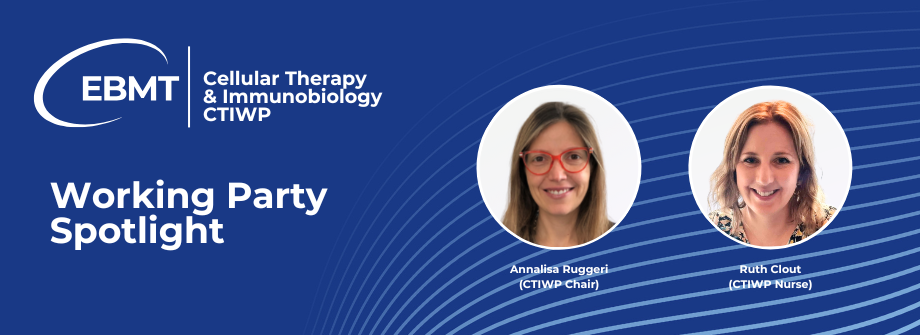
Interview with Annalisa Ruggeri (Chair) and Ruth Clout (Nurse Representative)
Introduce yourself and your role(s) and position(s) within EBMT and outside of EBMT
Annalisa Ruggeri: I am Annalisa Ruggeri. I work at the San Raffaele Hospital in Milano, Italy and I am a haematologist in the transplant and cellular therapy unit. I am the current chair of the CTIWP and the Scientific Council representative with the education portfolio and the Practice Harmonisation Committee Vice-Chair.
Ruth Clout: I am Ruth Clout and I am the Working Party nurse for the CTIWP. I work at the Christie Hospital in Manchester and I am a haematology matron where I lead the transplant and cellular therapy nursing team, haematology clinical nurse specialists, and the haematology/TYA clinical education team. Over my 25 years in this specialty, I have worked across both inpatient and outpatient haematology and transplant services, served as a transplant coordinator, and most recently as the senior clinical educator. I work closely with the university of Manchester and am the lead for the principles of Haematology MSc.
What are the main activities - in terms of research and education - that your Working Party has been leading? And is there a memorable project that you would like to highlight?
Annalisa Ruggeri: The CTIWP is an active group of collaborators and has several different activities in transplant and cell therapy, focusing on immunogenetics, and in the application and complication of cell therapy such as CART, namely fertility and outcomes for frail and old patients. Different projects have been published on HLA and other immunogenetic factors (Blood, JCO 2024), DLI (lanc Hema 2024) and CAR T (BMT 2024).
Ruth Clout: The CTIWP has active subcommittees, with members contributing to research projects and publications. As the Woking Party (WP) nurse, my focus is primarily on education, working closely with the Nurses Group. Alongside my EBMT nursing colleagues, I co-led the Cellular Therapy chapter in The EBMT Textbook for Nurses and contributed to the chapter in The EU CAR-T Handbook. I have also supported the CTIWP and Nurses group in the survey on nutritional practices during CAR-T. Additionally, I have been actively involved in speaking and chairing sessions at the EBMT and EHA European CAR T-cell Meeting and the Annual Meeting of the EBMT.
And are you facing any challenges or trends within your field that are affecting any current/on-going projects within your Working Party?
Annalisa Ruggeri: I am thankful to the different members of the CTIWP across the EBMT centres, sharing the experience and providing the inputs on a voluntary basis for covering the different projects and investigation. The main challenge is based on the time constraints and the easy access to the data, which may delay some processes.
Ruth Clout: Time constraints make coordinating meetings challenging, but collaborations are usually very positive, with strong multi-professional and international engagement.
What are your main goals in the near future?
Annalisa Ruggeri: Several different projects are ongoing and more will come in the near future! Our main goal is helping to understand biological / immunological processes in haematopoietic cell transplantation (HCT).
Implementing modern cellular therapies (including cell- and gene-engineering approaches) to improve outcomes of transplantation.
Fostering collaboration across centers, basic science, transplant immunobiology, and regulatory / manufacturing sides.
Ruth Clout: Exciting projects are on the horizon, including the first edition of the EBMT Exam for Nurses (learn more here) I look forward to continuing to contribute to education, supported by the expertise of the CTIWP.
Can you tell us what membership of your Working Party looks like? What do members of your Working Party get to do?
Annalisa Ruggeri: Being a Member of the CTIWP is being part of a community to participate in studies, surveys, or registries.
- Contribute data, protocols.
- Attend the CTIWP Meetings (scientific business meetings, educational workshops.
- Collaborate with other centres, committees, and stakeholders (e.g. regulatory bodies, industry, other Working Parties) to harmonise practice and regulatory / manufacturing standards.
- Help with writing and reviewing guidelines, position papers, consensus statements.
- Possibly contribute to educational content and events.
Ruth Clout: As cellular therapy continues to advance, the CTIWP offers me, in my role as the Working Party nurse, the opportunity to explore how these developments influence both nursing practice and patient care. By being a member of the CTIWP and working collaboratively with the Nurses Group, I can contribute to shaping nursing roles while ensuring patients receive the highest standard of care and support.
What would you like to say to encourage young investigators / trainees to join your Working Party?
Annalisa Ruggeri: Joining the CTIWP gives an excellent opportunity to build your network with healthcare professionals, increase the collaboration with other centres and share your challenges in patients care and clinical activities. We look forward to welcoming the young investigators to the CTIWP!
Ruth Clout: Being part of the CTIWP is interesting and gives an excellent opportunity to be part of exciting projects and opportunities, with collaboration across the EBMT Working Parties. For young investigators, this Working Party is a valuable platform to become actively involved, gain experience, and contribute to the advancement of the field.